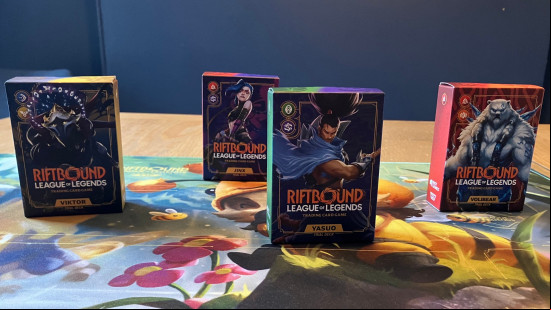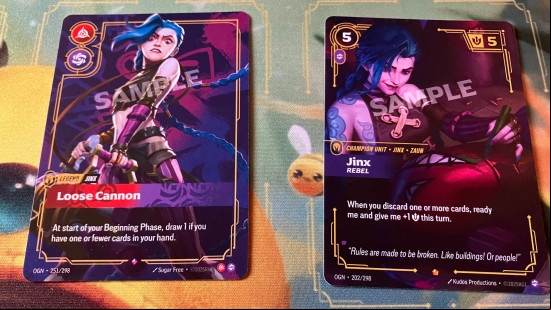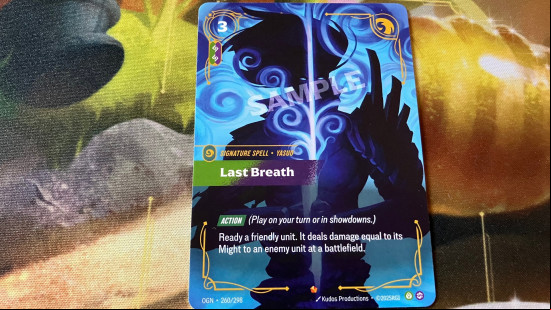If there's one thing I like more than the smell of pristine cards, fresh from their packs, it's getting to grips with brand-spanking-new trading card games. So I was delighted when Riot Games invited me to its Los Angeles campus to test out its League of Legends TCG, Riftbound.
A physical game sold in boosters, where you play with decks featuring your favorite card game, the ill-fated Legends of Runeterra.
Fans of Hearthstone or, in particular, MTG Arena won't find themselves too lost, however: the apple hasn't fallen far from the TCG tree. You accrue resources to cast spells, send units to fight your opponents' forces, and attempt to outwit your foe through canny cardplay. One unique wrinkle is an element of area control. Your ultimate objective is to capture several battlefields, scoring points as you take and then hold them.

Of course, while MOBA players and TCG fans share a head for strategy – the patience to spend hours learning metas, and the impulsiveness to spend way too much cash on their gaming hobbies – the genres don't have tons of obvious overlap. I was keen to find out how Riot would ensure the game appeals to League of Legends players, so I put the question to Riftbound's game director, Dave Guskin.
According to Guskin, it's all about the champions. "We have tried to translate them faithfully into this card game," Guskin says. "So, you know, Yasuo feels like Yasuo, Teemo feels like Teemo, Viktor feels like Viktor. Even though they're not exactly the same way that they play in League of Legends, we've tried to make sure that we've been faithful to their identity."
Each deck in Riftbound is built around a single champion, with three cards that form the backbone of your deck and encourage you to pursue a particular strategy. A Legend card gives you a unique power you always have access to, a Unit card represents your champion on the battlefield, and a Signature Spell (themed around one of the champion's abilities, like Volibear's Stormbringer or Jinx's Super Mega Death Rocket) slots in your deck ready for later.

Guskin gives the example of minion-dashing, windwalling samurai Yasuo, renowned for his "sudden, extreme [ability] to take out other champs." In Riftbound, that's portrayed through a power that can move units swiftly in or out of battlefields, and a champion that can deal major damage before a showdown begins. Another good illustration is the Jinx deck, which encourages you to pursue a reckless strategy where you discard your own cards – true to her chaotic, impulsive nature.
Another similarity Guskin draws between League and Riftbound is that both require players to choose exactly the right moment to activate a 'spike of power.'
"We think that this is a pretty cool expression of strategy, and similar to League of Legends strategy, it's about picking and choosing when you want to lane versus when you want to jungle. The mechanics are different, but the timing and the way that the game flows are reminiscent of that kind of play."
At the end of the day, it's the attachment to Riot's world and characters that will entice League players to give Riftbound a try. "People who are interested in League of Legends champions as collectibles will be interested in it," he says.

A physical TCG is an easy-to-obtain set of objects that "represent the champions you love, or the places and characters from Runeterra that you love." You only have to glance at how absolutely bananas Final Fantasy fans have gone for the Magic: The Gathering x FF cards to see the effect Riot is hoping to have.
Riot Games wants its cards to be desirable collectibles, which is probably why it scrambled to make changes when the poorly received 'Project K' card designs were revealed six months ago. Now the game not only has a name but a fresh new look. Riot has tweaked the card frames to match the visual language of Hextech – the magical steampunk aesthetic that Arcane brought to life in vivid detail. You'll see that the cards now better reflect League of Legends' core themes.
Of course, Riot already knows there's a market for a League of Legends card game. The elephant in the room is that Riftbound's release comes hot on the heels of what many of its fans would call the death of Legends of Runeterra. The mobile and PC game, which launched in 2020, stopped producing new PVP sets and ranked seasons in February 2024, switching to a mainly single-player experience.
I asked Guskin, who was also the lead on Runeterra until its latest phase, if he was worried Riot might have alienated the target audience for Riftbound. He says he's definitely seen some of that.
"I can totally understand if you're a LoR PVP player [and] you feel like 'hey, I got left in the dust,'" he explains, but hopes for "a positive reinforcement between the two teams.
"LoR obviously has a great amount of art that we're using now to help Origins and into future sets," he says. "We think that as we commission new art for Riftbound, we'll be able to send that back over to LoR."

One thing I noticed when playing Riftbound is that, regardless of how well its characters are represented, you do have to squint to see the connection to League. It wasn't hard to imagine a version of the game that was much more faithful. You could have units representing turrets, cards for each champion mapping directly onto their abilities, a more explicit lane system, and a win condition based on destroying your enemy's Nexus.
And, in fact, Guskin reveals that Riftbound looked a lot more like that earlier in development. "What we found was, actually, it was more fun and easier to make content and cards for more of a representational experience, as opposed to a truly faithful translation of the Rift," he explains.
One reason for this is that "it's just a lot to explain" to newbies. Riot wants its TCG to be as approachable as possible. Guskin sees Riftbound as a good entry point: a game that League fans can play in person with their friends, who might've seen Arcane but never touched the MOBA.
Of course, it won't take long for LoL to get its hooks in. Presumably, for most Riftbound players, it'll only be a matter of time before Summoner's Rift consumes their every waking hour.
Riftbound drops in China in the summer and in English-speaking countries in October this year. The game's first set, Origins, will be revealed between June 9 and July 18.
